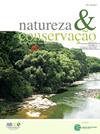南美洲干查科的鸟类群落:植被结构和气候影响
IF 3.5
2区 环境科学与生态学
Q1 BIODIVERSITY CONSERVATION
引用次数: 0
摘要
物种导致一个受外部过程影响的复杂动态环境。更好地了解这些因素的重要性对世界热带干燥森林来说尤为紧迫,因为对热带干燥森林的研究不足,受到高度威胁,正在迅速消失。基于野外鸟类群落数据集,采用多元分析和广义线性模型,研究了气候和植被结构对森林廊道鸟类组成和丰富度的影响。我们的分析揭示了森林走廊的重要性,它不仅可以连接景观,还可以促进物种的移动,在管理和连通性规划方面具有很高的潜力。我们发现,当关注所有鸟类或仅分析干林鸟类时,鸟类群落对环境变化的影响存在显著差异。对所有鸟类来说,组成揭示了它们对栖息地的偏好。开放生境的鸟类与冠层开度、温度和相对湿度呈正相关,而避开开放生境的鸟类与更高的冠层密度呈正相关。解释干旱林鸟类变化的最重要变量是林下植被和冠层密度。整个群落的丰富度随着温度的升高而增加,但白天较高的温度会减少鸟类的活动。总体而言,我们发现鸟类组成差异与林冠变化有关,但丰富度随林下覆盖而增加。同样,我们的研究强调了根据当地对组成或丰富程度的要求维持微环境的重要性。此外,保护战略应符合这些要求,以促进可能连接景观的走廊用途的可行性。本文章由计算机程序翻译,如有差异,请以英文原文为准。

Bird communities in the Dry Chaco of South America: vegetation structure and climate effects
Species lead to a complex and dynamic environment affected by external processes. Better understanding the importance of these factors is particularly urgent for the world’s tropical dry forest, which is understudied, highly threatened and rapidly disappearing. Building on a unique, field-based bird community dataset, we used multivariate analysis and generalized linear models to test the effects of climate and vegetation structure on bird composition and richness in forest corridors. Our analyses revealed the importance of forest corridors that not only connect the landscape but may facilitate the movement of species, having a high potential for management and connectivity planning. We found significant differences in bird communities to environmental changes when focusing on all birds or when analyzing dry-forest birds only. For all birds, composition revealed preferences of habitat. Birds of open habitats were positively associated with canopy openness, temperature, and relative humidity, while birds to avoid open habitats were positively associated with higher canopy density. The most important variables explaining variations of dry-forest birds were understory and canopy density. Richness increases with temperature for the entire community, yet higher temperatures during the day decrease bird activity. Overall, we showed that bird composition differences were associated with canopy changes, yet richness increased with understory cover. Likewise, our study highlights the importance of maintaining a microenvironment based on local requirements for composition or richness. Moreover, the conservation strategies should be consistent to those requirements to promote the viability of corridors uses that potentially connect the landscape.
求助全文
通过发布文献求助,成功后即可免费获取论文全文。
去求助
来源期刊

Perspectives in Ecology and Conservation
Environmental Science-Nature and Landscape Conservation
CiteScore
7.80
自引率
4.30%
发文量
46
审稿时长
59 days
期刊介绍:
Perspectives in Ecology and Conservation (PECON) is a scientific journal devoted to improving theoretical and conceptual aspects of conservation science. It has the main purpose of communicating new research and advances to different actors of society, including researchers, conservationists, practitioners, and policymakers. Perspectives in Ecology and Conservation publishes original papers on biodiversity conservation and restoration, on the main drivers affecting native ecosystems, and on nature’s benefits to people and human wellbeing. This scope includes studies on biodiversity patterns, the effects of habitat loss, fragmentation, biological invasion and climate change on biodiversity, conservation genetics, spatial conservation planning, ecosystem management, ecosystem services, sustainability and resilience of socio-ecological systems, conservation policy, among others.
 求助内容:
求助内容: 应助结果提醒方式:
应助结果提醒方式:


